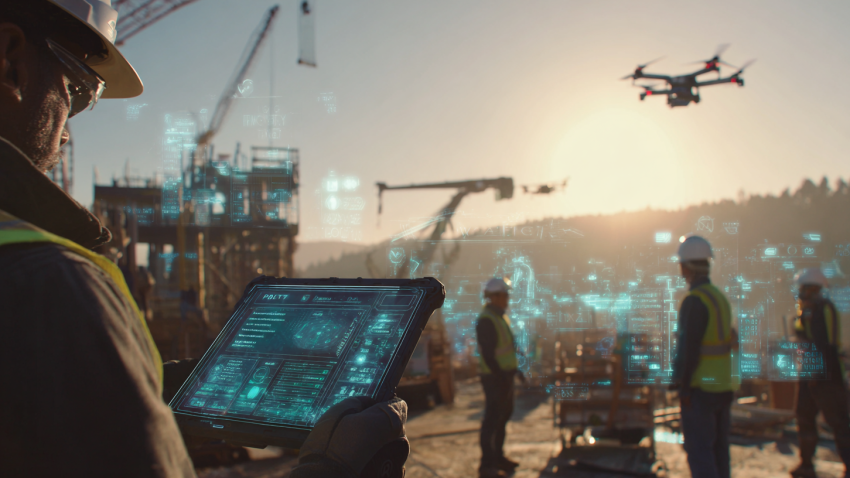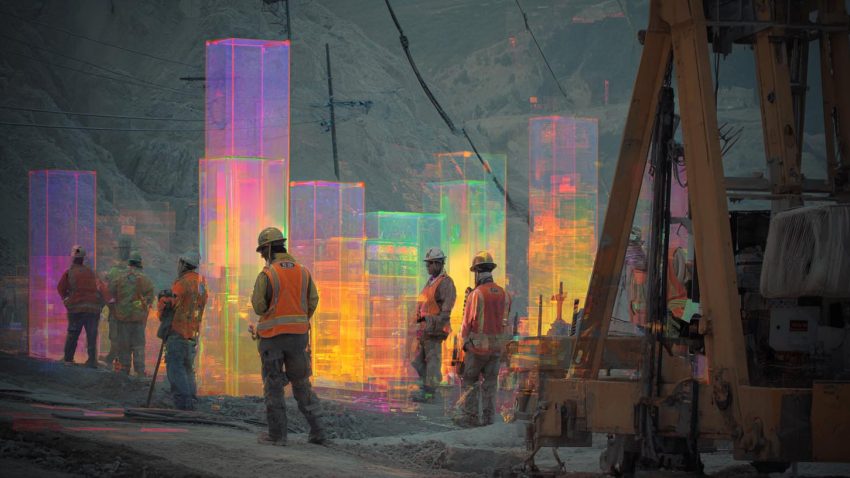Data Center Construction: Top Delivery and Scheduling Strategies for Redundant Power Systems in Data Centers
Table of Contents:
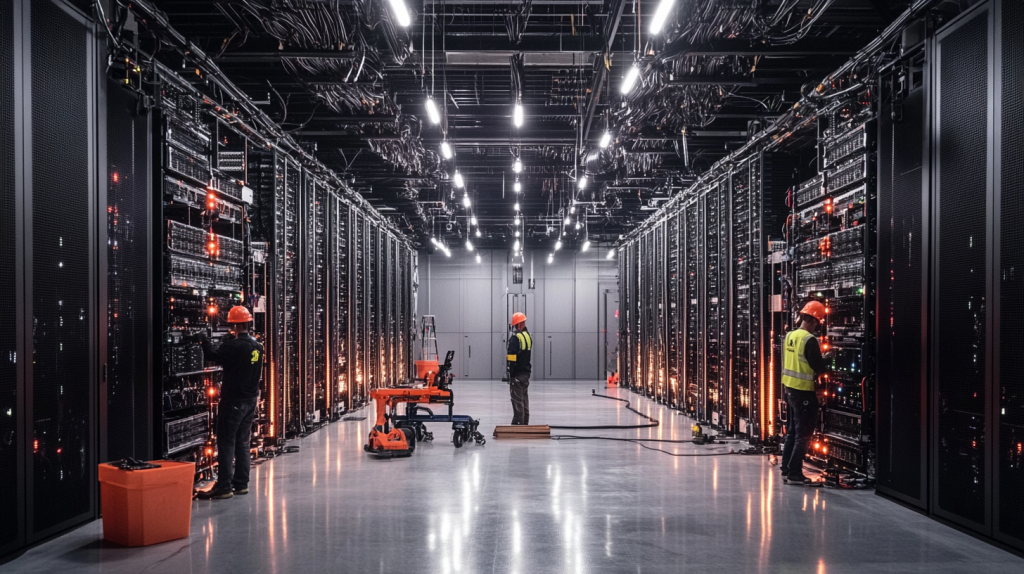
Building a data center is like constructing a small city, except instead of roads and traffic lights, you’ve got server racks, cooling systems, and enough power infrastructure to light up a small town. And if there’s one thing data centers absolutely cannot afford, it’s a power failure. That’s why redundant power systems—backup generators, UPS (Uninterruptible Power Supply) units, and secondary power grids—are a non-negotiable part of construction.
But installing redundant power infrastructure isn’t as simple as plugging in a few extension cords and hoping for the best. These systems require precise scheduling, coordinated deliveries, and meticulous installation sequencing to ensure everything is in place before the first server goes live.
In this guide, we’ll cover the best delivery and scheduling strategies to manage redundant power system installations efficiently. Whether you’re working on a hyperscale data center or a mission-critical colocation facility, these strategies will help keep the lights on (literally) and your project on track.
Why Scheduling Matters in Redundant Power System Installations
Let’s be real—timing is everything in data center construction, and when it comes to redundant power systems, bad scheduling can mean big trouble. These components aren’t your average hardware deliveries; they require heavy-duty transport, special storage conditions, and coordinated installation timelines to avoid bottlenecks.
Imagine this: Your UPS units arrive too early, and you don’t have secure storage, so they sit in an unprotected area, vulnerable to damage. Or worse, your backup generators arrive late, pushing back the entire electrical infrastructure installation. Either way, poor scheduling = unnecessary headaches.
Key Benefits
- Prevents Storage Issues: Ensures materials arrive only when needed.
- Reduces Installation Delays: Keeps construction phases aligned.
- Improves Contractor Coordination: Ensures that electrical teams are ready for installation.
Best Practices
- Use Just-in-Time Delivery – Schedule power system deliveries to align with installation dates.
- Coordinate with Electrical Contractors – Ensure teams are ready before equipment arrives.
- Track Deliveries in Real-Time – Use StruxHub to monitor shipments.
A well-planned delivery schedule ensures redundant power systems arrive on time, undamaged, and ready for installation, preventing costly delays and logistical nightmares.
Managing Multi-Phase Deliveries for Redundant Power Equipment
Redundant power systems don’t show up all at once—they arrive in phases, and managing these deliveries is key to maintaining construction flow. Large backup generators, UPS units, and switchgear components need to be transported and installed sequentially.
Failing to phase out deliveries properly can lead to on-site congestion, misplaced equipment, and storage nightmares. It’s like trying to move into a house while the movers dump everything into one room—you can’t install what you can’t reach.
Key Benefits
- Avoids Clutter on Construction Sites: Ensures power equipment is delivered in sequence.
- Optimizes Installation Workflow: Technicians get materials exactly when they need them.
- Reduces Equipment Damage Risks: Proper handling prevents storage-related issues.
Best Practices
- Schedule Deliveries by Installation Phase – Receive switchgear before UPS units to maintain logical workflow.
- Use RFID and Barcode Scanning – Log all incoming materials to prevent misplacement.
- Implement a Centralized Tracking System – StruxHub offers real-time visibility into shipments.
Phased deliveries ensure that redundant power equipment is installed in the right order, reducing downtime, confusion, and unnecessary handling risks.
Related Articles:

Coordinating Storage and Security for Redundant Power Equipment
Where do you store a 2,000-pound backup generator while waiting for the installation team? If you don’t have a plan, you’re in for a logistical nightmare.
Power equipment isn’t just big—it’s expensive, delicate, and vulnerable to environmental factors like moisture, dust, and extreme temperatures. Without secure, climate-controlled storage, your essential components could arrive in perfect condition but be compromised before installation.
Key Benefits
- Protects High-Value Equipment: Reduces exposure to damage.
- Improves Inventory Control: Ensures quick access to equipment when needed.
- Prevents Theft and Tampering: Secure storage minimizes security risks.
Best Practices
- Designate Climate-Controlled Storage Areas – Keep sensitive components like UPS units in a protected space.
- Use RFID Tracking for Inventory Management – Ensure each item is logged and traceable.
- Establish Security Protocols for High-Value Equipment – Restrict access to essential personnel only.
Proper storage planning prevents equipment damage, security risks, and unnecessary handling delays, ensuring everything is installation-ready when needed.

Reducing Delivery Delays with Predictive Supply Chain Analytics
In the world of data center construction, one delayed shipment can create a ripple effect that throws off the entire schedule. Using predictive analytics in supply chain management helps anticipate delivery risks before they become costly problems.
By analyzing historical delivery data, vendor performance, and external risk factors (like weather disruptions or transportation bottlenecks), predictive analytics identifies potential risks before they impact the project.
Key Benefits
- Reduces Unplanned Delays: Predictive insights allow proactive adjustments.
- Improves Supplier Accountability: Tracks vendor performance for more reliable deliveries.
- Enhances Decision-Making: Provides data-backed scheduling insights.
Best Practices
- Monitor Vendor Performance Trends – Identify which suppliers frequently miss deadlines.
- Use AI-Based Forecasting Tools – Leverage predictive analytics for improved scheduling.
- Integrate Supply Chain Data into Delivery Management Systems – StruxHub can track and analyze delivery metrics.
Predictive analytics turns guesswork into precision, reducing the risks of late or misplaced deliveries and ensuring that redundant power systems arrive exactly when needed.

StruxHub
Experience the power of StruxHub today and witness firsthand how it can revolutionize your construction operations.
Synchronizing Installation Schedules with Construction Timelines
Coordinating the installation of redundant power systems with overall construction timelines is a delicate balancing act. If power infrastructure is installed too early, it can sit idle, exposed to potential damage, environmental risks, or theft. On the other hand, if it arrives too late, critical systems won’t be operational when the facility comes online.
The best approach is phase-based scheduling, ensuring that components like switchgear, transformers, UPS units, and backup generators arrive and get installed in alignment with construction milestones. For example, backup power equipment should be on-site before the primary power systems go live, and UPS units must be fully tested before critical IT equipment arrives.
Using construction management platforms like StruxHub ensures that all teams—including electrical contractors, general contractors, and suppliers—are aligned on installation schedules and delivery sequences.
Key Benefits
- Eliminates Installation Delays: Ensures power systems are installed before IT loads come online.
- Reduces Unnecessary Storage Costs: Avoids premature deliveries of large equipment.
- Improves Workflow Efficiency: Ensures that electrical teams are prepared before components arrive.
Best Practices
- Use Gantt Charts for Scheduling – Track construction phases alongside power system installation timelines.
- Conduct Pre-Installation Coordination Meetings – Align delivery schedules with contractor availability.
- Implement Just-in-Time (JIT) Delivery – Prevents early or late material arrivals that disrupt workflow.
By synchronizing power system installations with overall construction timelines, data center teams reduce delays, minimize risk, and improve installation efficiency, ensuring seamless project execution.
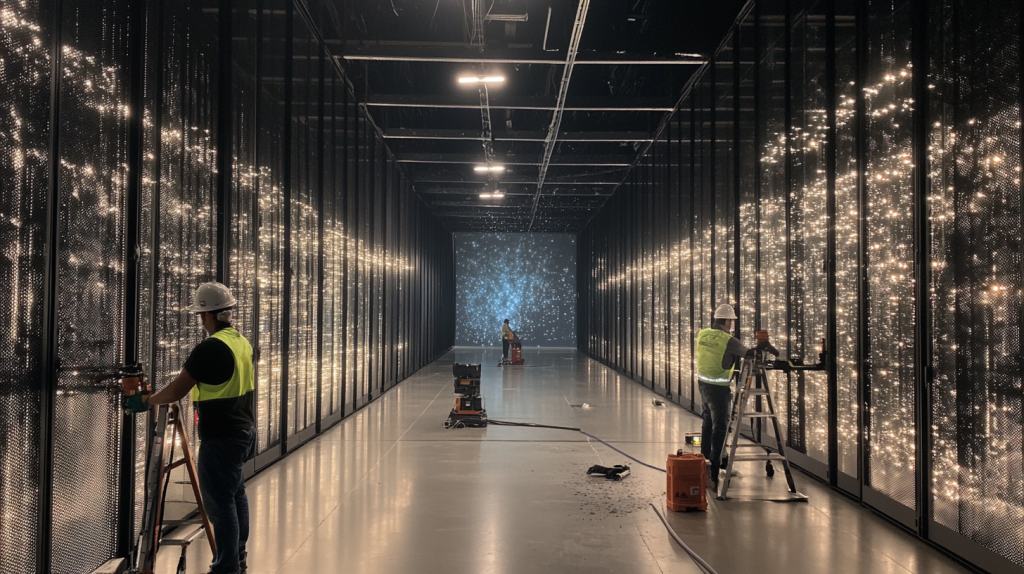
How AI is Revolutionizing Power Equipment Logistics
Artificial Intelligence (AI) is transforming logistics and supply chain management, and data center construction is no exception. AI-powered delivery tracking, predictive analytics, and automated scheduling tools are making power equipment logistics faster, smarter, and more reliable.
Traditional scheduling methods rely on human estimates, spreadsheets, and guesswork, which can lead to bottlenecks, last-minute rescheduling, and costly inefficiencies. AI eliminates these problems by analyzing historical data, tracking real-time shipment statuses, and predicting potential supply chain disruptions before they happen.
For example, AI-enabled logistics platforms can flag high-risk shipments (such as power distribution units stuck in transit) and suggest alternative delivery routes to avoid construction slowdowns. AI also improves vendor management by evaluating supplier reliability and automating procurement adjustments based on project needs.
Key Benefits
- Minimizes Supply Chain Disruptions: AI predicts delays and suggests alternative solutions.
- Improves Scheduling Accuracy: Dynamic scheduling adapts to real-time changes.
- Optimizes Vendor Performance: AI tracks supplier reliability and recommends the best delivery strategies.
Best Practices
- Use AI-Powered Logistics Platforms – Automate scheduling and track shipments with StruxHub.
- Analyze Historical Data for Improved Planning – AI can learn from past delivery trends to optimize future shipments.
- Integrate AI with GPS & RFID Systems – Enhance real-time tracking accuracy and reduce lost shipments.
AI-driven logistics provides unmatched efficiency in tracking, scheduling, and optimizing power system deliveries, helping data center projects stay on schedule and within budget.
The Future of Digital Twin Technology in Power System Delivery Optimization
Digital twin technology is rapidly reshaping how construction logistics are managed, allowing project teams to simulate, track, and optimize power system deliveries with real-time virtual models.
A digital twin is a real-time, AI-powered replica of a construction site that allows teams to visualize and test delivery strategies before physical execution. Instead of relying on static spreadsheets, construction managers can simulate different delivery schedules, analyze site storage capacity, and optimize power system installations before materials even arrive.
For example, before a backup generator shipment, a digital twin can predict the best delivery sequence, optimize the storage placement, and flag potential space constraints on-site. This level of foresight reduces delays, storage inefficiencies, and last-minute adjustments.
Key Benefits
- Enhances Planning Accuracy: Predicts challenges before deliveries happen.
- Optimizes Space Utilization: Prevents on-site congestion and material misplacements.
- Reduces Project Risks: Minimizes last-minute changes that cause delays.
Best Practices
- Integrate Digital Twin Tech with Construction Software – Sync real-time project data for accurate scheduling.
- Simulate Different Delivery Scenarios – Analyze multiple logistics strategies before committing to a plan.
- Use AI-Driven Insights for Real-Time Adjustments – Modify schedules based on site conditions and changing requirements.
Digital twin technology is revolutionizing power system logistics, enabling data center teams to predict challenges, optimize deliveries, and improve scheduling efficiency like never before.
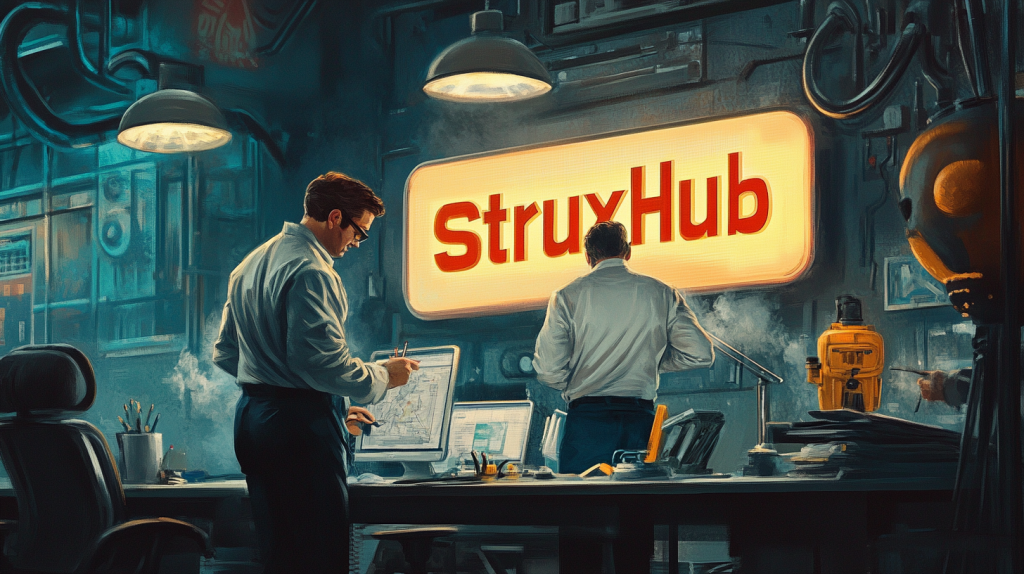
StruxHub: Revolutionizing Project Management in Large Commercial Construction
Unlock the Full Potential of Your Construction Projects with StruxHub
StruxHub enhances efficiency and coordination across all project phases, providing a single source of truth that eliminates silos and fosters collaboration. Real-time updates, financial management tools, and seamless commvunication features ensure that all team members and stakeholders are aligned and informed, reducing the risk of errors and delays. With comprehensive solutions for document management, risk mitigation, and quality control, StruxHub maintains project integrity and safety, while mobile access and integration capabilities further enhance project flexibility and efficiency.
StruxHub’s Key Features and Benefits:
- Advanced Delivery Management: Automate and optimize your delivery schedules, ensuring materials arrive just in time, every time.
- Site Communication: Utilize georeferenced maps and instant messaging to keep every team member informed and aligned.
- Construction Materials Management: Track inventory levels and manage materials procurement with ease, reducing waste and avoiding project delays.
- Construction Safety & Inspection Workflows: Implement customizable mobile forms for conducting safety inspections and managing compliance documentation effortlessly.
- Short-Term Scheduling: Visualize project tasks with detailed floor plans, linking each activity to specific locations for better planning accuracy.
- Construction Resource Management: Efficiently allocate personnel and equipment, maximizing productivity and reducing idle time.
StruxHub’s Product Offering:
- StruxHub Deliveries: Simplifies the coordination of incoming deliveries, ensuring materials and equipment are precisely timed to project needs.
- StruxHub Logistics: Offers intelligent site logistics planning, from crane scheduling to space allocation, for smoother operations.
- StruxHub Safety: Elevates on-site safety standards with easy-to-use tools for inspections, permits, and incident reporting.
- StruxHub Scheduling: Enhances project timelines with intuitive scheduling tools that ensure tasks are completed efficiently and on time.
With StruxHub, construction companies can look forward to a streamlined, more efficient project execution that delivers on time and within budget. Embrace the power of innovation and take your construction projects to the next level.
Don’t miss out on the opportunity to optimize your construction management processes with StruxHub. Sign up for a free demo today. Let’s build smarter, together.
FAQ
1. How does real-time tracking improve redundant power system deliveries?
Real-time tracking eliminates uncertainties by providing instant updates on shipment locations, estimated arrival times, and potential delays. For redundant power systems, which include UPS units, backup generators, and power distribution components, tracking ensures seamless installation sequencing without storage bottlenecks.
Platforms like StruxHub enhance efficiency by automating delivery updates, logging proof-of-delivery, and integrating AI-powered scheduling insights. This proactive approach reduces costly delays, prevents misplaced shipments, and streamlines electrical installation workflows.
Real-time tracking also minimizes communication breakdowns. Instead of manually checking with suppliers or waiting for status reports, project managers can access a centralized dashboard that provides live shipment status, expected delivery times, and alerts for any disruptions. With these insights, teams can adjust labor schedules, plan storage logistics, and keep the project running smoothly.
2. What are the biggest challenges in scheduling power system installations?
Scheduling redundant power system installations comes with challenges like logistical delays, supply chain disruptions, and site access constraints. Coordinating multiple vendors while ensuring that switchgear, UPS units, and cooling systems arrive in the correct sequence requires advanced planning and scheduling tools.
One of the most significant issues is misalignment between contractors and material deliveries. If electrical engineers are scheduled for installation but generators or UPS units haven’t arrived, labor costs increase while workers sit idle. Similarly, if deliveries arrive too early, they may clog up storage areas or risk damage from improper handling.
Using AI-based logistics solutions reduces miscommunication, prevents storage congestion, and aligns installation phases, ensuring every component arrives at the right time for deployment. Additionally, predictive scheduling tools help project managers forecast delivery delays and create backup procurement plans to mitigate risks.
3. How can AI prevent supply chain disruptions in data center construction?
AI is transforming supply chain management by predicting risks before they impact deliveries, enabling teams to proactively reroute shipments, adjust schedules, and optimize vendor performance. Unlike traditional supply chain tracking, which relies on historical trends, AI-driven platforms continuously analyze real-time logistics data to flag potential bottlenecks and risks.
For example, if AI detects that a supplier frequently delivers late, it can suggest alternative vendors or recommend adjusting order timelines to accommodate potential delays. Similarly, AI can analyze weather data, traffic patterns, and geopolitical factors to anticipate transportation issues before they occur.
Using AI-integrated logistics software, such as StruxHub, teams can automate scheduling adjustments, receive alerts for unexpected disruptions, and ensure every power system component arrives on time and in the right sequence. AI-driven optimization results in fewer delays, lower costs, and improved construction efficiency.
4. What security measures should be taken for high-value power equipment?
Power systems are among the most expensive components in data center construction, making security a top priority. Backup generators, UPS units, and electrical switchgear must be protected against theft, tampering, and environmental damage while in transit and on-site.
One essential security measure is GPS-enabled tracking, which allows teams to monitor shipments in real-time and ensure that they remain on the correct route. Additionally, RFID tagging helps track individual equipment components, ensuring that nothing goes missing during transportation or storage.
On-site, secure storage solutions are critical. Climate-controlled warehouses prevent moisture damage, while restricted access protocols ensure that only authorized personnel can handle or install power systems. Installing surveillance cameras and implementing 24/7 security monitoring further reduces risks.
By combining GPS tracking, RFID inventory control, and on-site security measures, data center construction teams can ensure that high-value power equipment remains secure, intact, and ready for installation.
5. How does digital twin technology improve scheduling for redundant power systems?
Digital twin technology is revolutionizing construction logistics by creating real-time virtual models of a project’s physical infrastructure. These models help simulate and optimize delivery schedules, ensuring that redundant power systems arrive at the right time and location without disrupting site operations.
By integrating 3D modeling, AI-driven scheduling, and real-time logistics data, digital twins can identify potential conflicts in delivery timing, optimize storage placement, and eliminate unnecessary bottlenecks. For example, before a backup generator shipment, a digital twin can predict the best delivery sequence, optimize the storage placement, and flag potential space constraints on-site.
This level of predictive planning ensures that every component arrives exactly when it is needed, reducing storage congestion, handling risks, and unexpected installation delays. StruxHub integrates digital twin technology into its logistics framework, helping construction managers visualize material movement and optimize construction workflows before physical execution.
With digital twin technology, data center teams can optimize scheduling, reduce waste, and improve efficiency, making it a game-changer for redundant power system logistics.


